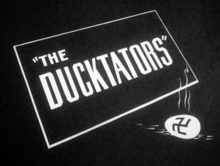The Ducktators
| The Ducktators | |
|---|---|
 | |
| Directed by | Norman McCabe |
| Story by | Melvin Millar |
| Produced by | Leon Schlesinger |
| Starring | |
| Narrated by | John McLeish[1] |
| Music by | Carl W. Stalling |
| Animation by | John Carey |
| Color process | Black and White |
Production company | |
| Distributed by | Warner Bros. Pictures |
Release date |
|
Running time | 7:43 |
| Country | United States |
| Language | English |
The Ducktators is a 1942 Warner Bros. Looney Tunes short directed by Norman McCabe.[2] The short was released on August 1, 1942, and satirizes events of World War II.[3] The title is a pun on dictator.
Plot[edit]
A pair of farm ducks eagerly await the hatching of their duckling from a uniquely black-colored egg. To their surprise, a white duckling with a toothbrush mustache emerges, named Adolf Hitler, who immediately begins shouting "Sieg Heil!" and giving the Nazi salute. Throughout his adulthood, Hitler gives aggressive speeches to the other ducks and geese, with his only ally being a large Neapolitan-accented goose named Benito Mussolini.
As Hitler's stormtroopers surround the farm, a Dove of Peace watches from above, weeping at the impending violence. A peace conference is attempted, but Hitler disrupts it by shredding the peace treaty and inciting a brawl. Meanwhile, a peculiar Japanese duck named Hideki Tojo arrives to support Hitler and Mussolini but inadvertently angers a sea turtle by mistaking it for an island and planting a sign on its shell.
The trio of Hitler, Mussolini, and Tojo set out to conquer the farm, but the Dove of Peace, aided by chickens, a rescued chick, and a rabbit resembling Jerry Colonna, thwarts their plans. The Dove then proudly displays the defeated trio's heads as trophies while encouraging patriotism through buying state bonds.
Political references[edit]
The duckling that hatched from the egg had a mustache and a Nazi emblem throughout the cartoon, indicating that this character symbolized Adolf Hitler. The goose who became a comrade to the duck had an open Italian accent and, at the end of one of his speeches, a chick can be heard yelling "Duce!" multiple times, indicating that this goose is Benito Mussolini. The second duck utilized the flag of the Empire of Japan, and openly sang "The Japanese Sandman". He is presumably intended to be Hideki Tojo, judging by the military hat he is wearing.[4] However, he is commonly misidentified as Hirohito. The black duck may be a reference to Rommel as he was also from South Germany and spoke with an accent, but can also relate to how African Americans were a huge demographic in the Southern United States at the time.
Changes in Sunset Productions version[edit]
The original ending, featuring the Dove proudly displaying his defeated enemies' heads above the fireplace and urging viewers to buy war bonds, was rarely seen after the short was sold to Sunset Productions in the 1950s and syndicated through Guild Films. While the cartoon is in the public domain, this edited version has often appeared on VHS and DVD collections. However, the uncut and uncensored full ending can be found on the Looney Tunes Golden Collection: Volume 6 DVD set and in the World War II cartoons special on the Cartoon Network show ToonHeads.[5]
Reception[edit]
The Film Daily called the short "Acceptable", saying, "Hitler, Mussolini and Hirohito are taken for a ride – a one-way ride – in this animated cartoon, which produces many laughs at their expense."[6]
Home media[edit]
Due to the short's World War II stereotypes, it has rarely been shown on American television, except for Cartoon Network as part of its anthology television show, ToonHeads. The Ducktators is available uncut on Looney Tunes Golden Collection: Volume 6, Disc 2.
See also[edit]
References[edit]
- ^ a b Scott, Keith (2022). Cartoon Voices from the Golden Age, 1930–70. BearManor Media. p. 51. ISBN 979-8-88771-010-5.
- ^ Beck, Jerry; Friedwald, Will (1989). Looney Tunes and Merrie Melodies: A Complete Illustrated Guide to the Warner Bros. Cartoons. Henry Holt and Co. p. 131. ISBN 0-8050-0894-2.
- ^ Lenburg, Jeff (1999). The Encyclopedia of Animated Cartoons. Checkmark Books. pp. XXX. ISBN 0-8160-3831-7. Retrieved 6 June 2020.
- ^ Schneider, Steve (1988). That's All, Folks! : The Art of Warner Bros. Animation. Henry Holt and Co. p. 86. ISBN 0-8050-0889-6.
- ^ "The Censored Looney Tunes and Merrie Melodies Guide: D". Archived from the original on 2016-05-05. Retrieved 2016-09-12.
- ^ "Reviews of Short Subjects". The Film Daily. 82 (56): 6. September 17, 1942. Retrieved 7 November 2020.
External links[edit]
- 1942 films
- 1942 short films
- 1942 animated films
- 1940s animated short films
- 1940s English-language films
- 1940s Warner Bros. animated short films
- American black-and-white films
- American World War II propaganda shorts
- World War II films made in wartime
- Looney Tunes shorts
- Ethnic humour
- Stereotypes of East Asian people
- Japan in non-Japanese culture
- Films based on real people
- Animation based on real people
- Cultural depictions of Adolf Hitler
- Cultural depictions of Benito Mussolini
- Cultural depictions of Hideki Tojo
- Animated films about chickens
- Animated films about ducks
- Animated films about geese
- Films about fascism
- Films set in 1942
- Fictional geese
- Films directed by Norman McCabe
- Films produced by Leon Schlesinger
- Films scored by Carl Stalling
- Warner Bros. Cartoons animated short films
- Animated World War II films
